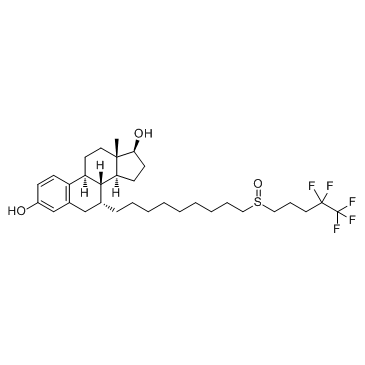Fulvestrant

Fulvestrant structure
|
Common Name | Fulvestrant | ||
|---|---|---|---|---|
| CAS Number | 129453-61-8 | Molecular Weight | 606.771 | |
| Density | 1.2±0.1 g/cm3 | Boiling Point | 674.8±55.0 °C at 760 mmHg | |
| Molecular Formula | C32H47F5O3S | Melting Point | 104-106°C | |
| MSDS | Chinese USA | Flash Point | 361.9±31.5 °C | |
|
Combined histone deacetylase inhibition and tamoxifen induces apoptosis in tamoxifen-resistant breast cancer models, by reversing Bcl-2 overexpression.
Breast Cancer Res. 17 , 26, (2015) The emergence of hormone therapy resistance, despite continued expression of the estrogen receptor (ER), is a major challenge to curing breast cancer. Recent clinical studies suggest that epigenetic modulation by histone deacetylase (HDAC) inhibitors reverses... |
|
|
PKA signaling drives mammary tumorigenesis through Src.
Oncogene 34(9) , 1160-73, (2015) Protein kinase A (PKA) hyperactivation causes hereditary endocrine neoplasias; however, its role in sporadic epithelial cancers is unknown. Here, we show that heightened PKA activity in the mammary epithelium generates tumors. Mammary-restricted biallelic abl... |
|
|
Elevated peritoneal expression and estrogen regulation of nociceptive ion channels in endometriosis.
J. Clin. Endocrinol. Metab. 99(9) , E1738-43, (2014) Ovarian suppression is a common treatment for endometriosis-associated pelvic pain. Its exact mechanism of action is poorly understood, although it is assumed to reflect reduced production/action of estrogens.The objective of the study was to measure the expr... |
|
|
Cross-talk between ER and HER2 regulates c-MYC-mediated glutamine metabolism in aromatase inhibitor resistant breast cancer cells.
J. Steroid Biochem. Mol. Biol. 149 , 118-27, (2015) Resistance to endocrine therapies in hormone receptor (HR)-positive breast cancer is a significant clinical problem for a considerable number of patients. The oncogenic transcription factor c-MYC (hereafter referred to as MYC), which regulates glutamine metab... |
|
|
Aromatase (Cyp19a1b) in the pituitary is dynamically involved in the upregulation of lhb but not fshb in the vitellogenic female ricefield eel Monopterus albus.
Endocrinology 155(11) , 4531-41, (2014) Aromatase, encoded by Cyp19a1, is expressed in the pituitary of vertebrates; however, its physiological relevance remains poorly defined. In teleosts, the duplicated cyp19a1b is preferentially expressed in the pituitary where LH and FSH are synthesized in dis... |
|
|
17β-Estradiol Abrogates Apoptosis Inhibiting PKCδ, JNK, and p66Shc Activation in C2C12 Cells.
J. Cell. Biochem. 116 , 1454-65, (2015) 17β-Estradiol (E2) protects several non-reproductive tissues from apoptosis, including skeletal muscle. Previously, we showed that E2 at physiological concentrations prevented apoptosis induced by H2O2 in skeletal myoblasts. As we have also demonstrated a cle... |
|
|
Aurora kinase A and B as new treatment targets in aromatase inhibitor-resistant breast cancer cells.
Breast Cancer Res. Treat. 149(3) , 715-26, (2015) Aromatase inhibitors (AIs) are used for treatment of estrogen receptor α (ER)-positive breast cancer; however, resistance is a major obstacle for optimal outcome. This preclinical study aimed at identifying potential new treatment targets in AI-resistant brea... |
|
|
A kinase inhibitor screen identifies Mcl-1 and Aurora kinase A as novel treatment targets in antiestrogen-resistant breast cancer cells.
Oncogene 34 , 4199-210, (2015) Antiestrogen resistance is a major problem in breast cancer treatment. Therefore, the search for new therapeutic targets and biomarkers for antiestrogen resistance is crucial. In this study, we performed a kinase inhibitor screen on antiestrogen responsive MC... |
|
|
Aurora kinase B is important for antiestrogen resistant cell growth and a potential biomarker for tamoxifen resistant breast cancer.
BMC Cancer 15 , 239, (2015) Resistance to antiestrogen therapy is a major clinical challenge in the treatment of estrogen receptor α (ER)-positive breast cancer. The aim of the study was to explore the growth promoting pathways of antiestrogen resistant breast cancer cells to identify b... |
|
|
Overcoming endocrine resistance due to reduced PTEN levels in estrogen receptor-positive breast cancer by co-targeting mammalian target of rapamycin, protein kinase B, or mitogen-activated protein kinase kinase.
Breast Cancer Res. 16(5) , 430, (2015) Activation of the phosphatidylinositol 3-kinase (PI3K) pathway in estrogen receptor α (ER)-positive breast cancer is associated with reduced ER expression and activity, luminal B subtype, and poor outcome. Phosphatase and tensin homolog (PTEN), a negative reg... |